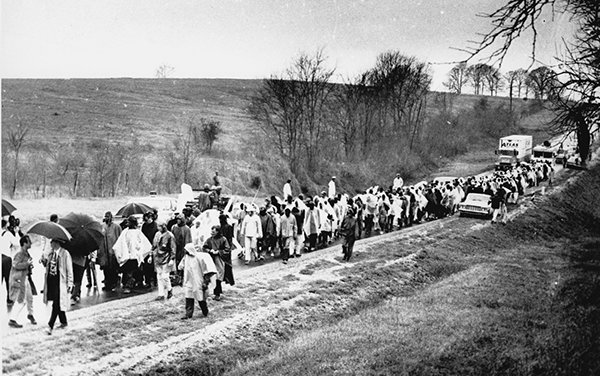—Hasan Kwame Jeffries
[Note: This piece was inspired by the author’s remarks at a recent event honoring Dr. King’s birthday, hosted by the National Civil Rights Museum in Memphis, Tennessee.]
There is no right more fundamental in a democracy than the right to vote. But fifty years ago, in 1965, African Americans throughout the South were denied this most basic right.
In some places, like Selma, Alabama, a handful of African Americans could vote. But in many places, especially in rural areas, the exclusion of African Americans from the ballot box was absolute. In Lowndes County, Alabama, the county neighboring Selma, there were 5,122 African Americans of voting age in 1965, but not a single one was registered. And this kind of absolute exclusion was common throughout the Black Belt, those counties whose populations were overwhelmingly African American.
Dr. Martin Luther King understood how vitally important the ballot was.

Photo: Associated Press.
That’s why, in 1965, he directed his energies, and the resources of the Southern Christian Leadership Conference (SCLC), toward drawing the nation’s attention to black disenfranchisement by dramatizing the exclusion of black people from the ballot box in Selma.
Speaking at the conclusion of the Selma-to-Montgomery March, Dr. King said: “The Civil Rights Act of 1964 gave Negroes some part of their rightful dignity, but without the vote it was dignity without strength.”
The importance of the ballot was no new revelation to black people in 1965. One hundred years earlier, when the shackles of slavery were finally shattered, Frederick Douglass, the outspoken abolitionist, said: “Slavery is not abolished until the black man has the ballot.” And for the next century, African Americans fought vigorously for the ballot, often losing their lives in the process.
So it is critically important to locate Selma on the long continuum of the African American struggle for freedom—which included, of course, not only fighting for the ballot, but also fighting for quality education, land ownership, fair wages, decent housing, and personal safety.
And, just as the continuum of the African American freedom struggle stretches backward in time, so, too, it stretches forward.
Today, fifty years after Selma, we find the voting rights of African Americans still under threat. Not the voting rights of all African Americans, as once was the case, but of just enough to make a difference in local, state, and federal elections. And not just in the South, but far beyond Dixieland. That’s what the wave of voter ID laws sweeping across the country is all about—restricting the franchise, rather than maintaining its integrity. And the US Supreme Court, of course, has cleared a path for these laws, especially in the worst offending states, by eliminating the requirement to submit proposed voting-law changes to the Justice Department for preclearance.
And the broader freedom struggle continues as well, including the struggle for personal safety. In Selma, Alabama, Governor George Wallace’s state troopers and Sheriff Jim Clark’s posse enforced state-sponsored racial terrorism. And today, in the streets of Ferguson, Missouri, New York City, and Cleveland, Ohio, young people are fighting the legacy of police enforced state-sponsored racial terrorism.
And so, fifty years after Selma, the struggle for basic civil and human rights continues, because the denial of these basic rights continues. But there is some good news. Despite setbacks in the African American freedom struggle, this movement will never be defeated because truth, justice, and righteousness have always been and will continue to be on the side of the People. As Dr. King said at the end of the Selma-to-Montgomery March, “The arc of the moral universe is long, but it bends toward Justice.”
Hasan Kwame Jeffries is Associate Professor of History at The Ohio State University, where he holds a joint appointment at the Kirwan Institute for the Study of Race and Ethnicity. He is the author of Bloody Lowndes: Civil Rights and Black Power in Alabama’s Black Belt (NYU Press, 2010).
